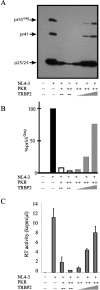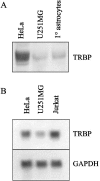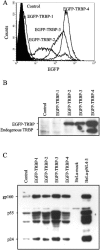Low TRBP levels support an innate human immunodeficiency virus type 1 resistance in astrocytes by enhancing the PKR antiviral response
- PMID: 16188979
- PMCID: PMC1235869
- DOI: 10.1128/JVI.79.20.12763-12772.2005
Low TRBP levels support an innate human immunodeficiency virus type 1 resistance in astrocytes by enhancing the PKR antiviral response
Abstract
Acute human immunodeficiency virus type 1 (HIV-1) replication in astrocytes produces minimal new virus particles due, in part, to inefficient translation of viral structural proteins despite high levels of cytoplasmic viral mRNA. We found that a highly reactive double-stranded (ds) RNA-binding protein kinase (PKR) response in astrocytes underlies this inefficient translation of HIV-1 mRNA. The dsRNA elements made during acute replication of HIV-1 in astrocytes triggers PKR activation and the specific inhibition of HIV-1 protein translation. The heightened PKR response results from relatively low levels of the cellular antagonist of PKR, the TAR RNA binding protein (TRBP). Efficient HIV-1 production was restored in astrocytes by inhibiting the innate PKR response to HIV-1 dsRNA with dominant negative PKR mutants, or PKR knockdown by siRNA gene silencing. Increasing the expression of TRBP in astrocytes restored acute virus production to levels comparable to those observed in permissive cells. Therefore, the robust innate PKR antiviral response in astrocytes results from relatively low levels of TRBP expression and contributes to their restricted infection. Our findings highlight TRBP as a novel cellular target for therapeutic interventions to block productive HIV-1 replication in cells that are fully permissive for HIV-1 infection.
Figures






Similar articles
-
Multiple levels of PKR inhibition during HIV-1 replication.Rev Med Virol. 2011 Jan;21(1):42-53. doi: 10.1002/rmv.674. Epub 2010 Dec 7. Rev Med Virol. 2011. PMID: 21294215 Review.
-
Small interfering RNAs against the TAR RNA binding protein, TRBP, a Dicer cofactor, inhibit human immunodeficiency virus type 1 long terminal repeat expression and viral production.J Virol. 2007 May;81(10):5121-31. doi: 10.1128/JVI.01511-06. Epub 2007 Mar 14. J Virol. 2007. PMID: 17360756 Free PMC article.
-
Dual role of TRBP in HIV replication and RNA interference: viral diversion of a cellular pathway or evasion from antiviral immunity?Retrovirology. 2005 Oct 27;2:65. doi: 10.1186/1742-4690-2-65. Retrovirology. 2005. PMID: 16253139 Free PMC article.
-
Binding of the influenza A virus NS1 protein to PKR mediates the inhibition of its activation by either PACT or double-stranded RNA.Virology. 2006 May 25;349(1):13-21. doi: 10.1016/j.virol.2006.01.005. Epub 2006 Feb 8. Virology. 2006. PMID: 16466763
-
The dsRNA protein kinase PKR: virus and cell control.Biochimie. 2007 Jun-Jul;89(6-7):799-811. doi: 10.1016/j.biochi.2007.03.001. Epub 2007 Mar 12. Biochimie. 2007. PMID: 17451862 Review.
Cited by
-
STAT3 and its phosphorylation are involved in HIV-1 Tat-induced transactivation of glial fibrillary acidic protein.Curr HIV Res. 2015;13(1):55-63. doi: 10.2174/1570162x13666150121115804. Curr HIV Res. 2015. PMID: 25613134 Free PMC article.
-
Endocytosis of human immunodeficiency virus 1 (HIV-1) in astrocytes: a fiery path to its destination.Microb Pathog. 2015 Jan;78:1-6. doi: 10.1016/j.micpath.2014.11.003. Epub 2014 Nov 4. Microb Pathog. 2015. PMID: 25448132 Free PMC article. Review.
-
Interferon-Stimulated Genes that Target Retrovirus Translation.Viruses. 2024 Jun 8;16(6):933. doi: 10.3390/v16060933. Viruses. 2024. PMID: 38932225 Free PMC article. Review.
-
The presence of the TAR RNA structure alters the programmed -1 ribosomal frameshift efficiency of the human immunodeficiency virus type 1 (HIV-1) by modifying the rate of translation initiation.Nucleic Acids Res. 2008 Jan;36(1):30-40. doi: 10.1093/nar/gkm906. Epub 2007 Nov 5. Nucleic Acids Res. 2008. PMID: 17984074 Free PMC article.
-
Roles of long non-coding RNAs and emerging RNA-binding proteins in innate antiviral responses.Theranostics. 2020 Jul 23;10(20):9407-9424. doi: 10.7150/thno.48520. eCollection 2020. Theranostics. 2020. PMID: 32802200 Free PMC article. Review.
References
-
- Adelson, M. E., C. Martinand-Mari, K. T. Iacono, N. F. Muto, and R. J. Suhadolnik. 1999. Inhibition of human immunodeficiency virus (HIV-1) replication in SupT1 cells transduced with an HIV-1 LTR-driven PKR cDNA construct. Eur. J. Biochem. 264:806-815. - PubMed
-
- Bagasra, O., E. Lavi, L. Bobroski, K. Khalili, J. P. Pestaner, R. Tawadros, and R. J. Pomerantz. 1996. Cellular reservoirs of HIV-1 in the central nervous system of infected individuals: identification by the combination of in situ polymerase chain reaction and immunohistochemistry. AIDS 10:573-585. - PubMed
-
- Balachandran, S., P. C. Roberts, L. E. Brown, H. Truong, A. K. Pattnaik, D. R. Archer, and G. N. Barber. 2000. Essential role for the dsRNA-dependent protein kinase PKR in innate immunity to viral infection. Immunity 13:129-141. - PubMed
-
- Bannwarth, S., L. Talakoub, F. Letourneur, M. Duarte, D. F. Purcell, J. Hiscott, and A. Gatignol. 2001. Organization of the human tarbp2 gene reveals two promoters that are repressed in an astrocytic cell line. J. Biol. Chem. 276:48803-48813. - PubMed
Publication types
MeSH terms
Substances
LinkOut - more resources
Full Text Sources

